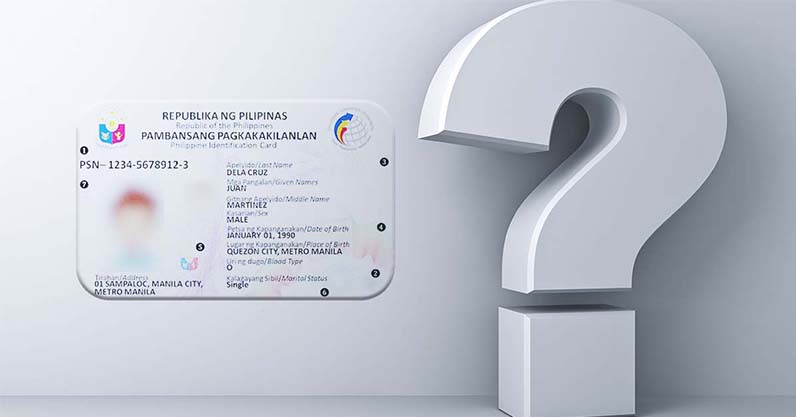Here Are Some Updates On The Philippine National ID System
4 min readA few weeks ago, President Rodrigo Duterte remarked that the implementation of the national ID system before the enhanced community quarantine could’ve sped up the distribution of government aid to the needy. He was referring to the Philippine Identification System (PhilSys) Act, which he signed in 2018.

It has been two years since the government announced the launch of the national ID system, with the 100 percent coverage of the program slated to happen in 2022.
Amid the COVID-19 crisis, people are now asking: What happened to the national ID system of the Philippines, and can it be rolled out sooner?
Timeline of the PhilSys Act
How far have we come as far as the rollout is concerned? Here are the most important milestones of the national ID system and the target dates for the gradual implementation of the program:
- September 2017. The House of Representatives approved House Bill No. 6221 with an overwhelming vote, proposing a universal identification system for Filipinos to easily access government services.
- March 2018. The Senate on third and final reading approved the upper house version of the PhilSys Act. Before the month ended, a bicameral conference green-lit the senate version of the law with minor revisions, passing the law to President Duterte for signature.
- August 2018. President Duterte signed Republic Act No. 11055 into law, instructing the Philippine Statistics Authority (PSA) to craft the implementing rules and regulations of the national ID system.
- October 2018. Former National Statistician and Civil Registrar General of the PSA Lisa Grace Bersales announced the commencement of the bidding process for the PhilSys.
- November 2018. The PSA teamed up with the Philippine Postal Corporation for the concept, with both agencies targeting seven million Filipinos for the pilot program in 2019.
- January 2019. The original target of seven million was adjusted to five million Filipinos to test the registration and transaction number generation. This made the pilot launch feasible in September 2019.
- September 2019. The PSA reported the start of the pilot testing of the national ID system in Metro Manila, with current National Statistician and Civil Registrar General Claire Dennis Mapa saying that the government is on track with the full implementation in 2022. Mass registration will be opened to the public in as early as July 2020. The trial period is set to last until February 2020.
- October 2019. Bangko Sentral ng Pilipinas Governor Benjamin E. Diokno announced that distribution of the national ID for early registrants can be possible in as early as April 2020.
- November 2019. The PSA included the members of the House of Representatives, along with their congressional staff and employees, to be part of the pilot testing from November to December 2019. They expect around 4,300 individuals to take part in helping the government make the system more streamlined. In addition, other concerned agencies will also be included in the future, which will be done until June 2020.
- April 2020. Due to ECQ guidelines, the PSA is indefinitely suspending the frontline registration platforms for the pilot test program of the PhilSys. No word yet as to when the program will resume.
Requirements for national ID application
As of this writing, the PhilSys Application Form No. 1 is not available yet according to both the PhilSys ID website and the PSA. But in any case, it would be a good to have any two of the following documentary requirements on hand:
- PSA-issued birth certificate and a government-issued ID that has your full name, photo, and signature/thumbmark on it
- Philippine ePassport issued by the Department of Foreign Affairs
- Unified Multipurpose Identification (UMID) card issued by the GSIS or SSS
- Other identification documents in line with the guidelines issued by the PSA
- For resident aliens: Alien Certificate of Registration (ACR) or ACR ID
- For married women with IDs reflecting their maiden name: PSA-issued marriage certificate should she opt use her husband’s surname
PhilSys in the time of COVID-19
How would a centralized identification system have helped in times of disaster?
If the plans for PhilSys Act had been fully implemented even before the COVID-19 pandemic, the government would’ve had a centralized registration for all Filipinos. This will make delivery of government services more convenient, which is especially beneficial for the poorest of the poor who don’t have sufficient proof of identification.
In addition to a centralized list of individuals, the PhilSys ID will also make application of services much more convenient. It will basically eliminate redundancies in registration such as multiple forms and others.
In case you don’t have an ID with you, you can just tell your PhilSys number to any government office and they can easily look you up for your proof of identity.
Meanwhile, those who are receiving government aid such as the conditional cash transfer program and the social amelioration programs of the Department of Social Welfare and Development can be easily identified through their IDs. It will also prevent people from making bogus registrations and eliminate duplicates on their list, making more room for people who actually deserve government aid.
Indeed, having a national ID system in times of crisis may come in handy. But the program is still in its infancy even before the quarantine, which makes it unfair for the PSA and other agencies working on the PhilSys ID to be blamed.
Here’s hoping the PhilSys ID timetable won’t be pushed back and for every Filipino to be registered eventually.
